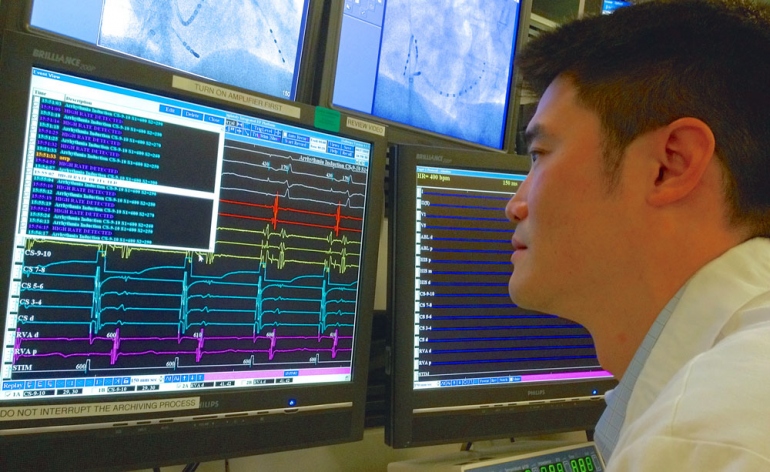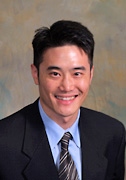Tseng Receives Funding to Study HIV/AIDS, Sudden Cardiac Death
UCSF Electrophysiologist Will Also Assist in CDC’s Sudden Death in the Young Registry

Zian Tseng, MD, reviews the electrical activity of a patient’s heart at the UCSF Heart & Vascular Center’s Electrophysiology Lab.
Zian H. Tseng, MD, MAS, associate professor of medicine in residence in the Cardiology Division and Cardiac Electrophysiology Service at UC San Francisco, received a four-year $2.14 million grant from the National Institutes of Health (NIH) to expand on his research of people with HIV/AIDS and their increased risk of sudden cardiac death.
Tseng also earned a separate $140,000 award from the Centers for Disease Control and Prevention to assist in the four-year development of a national Sudden Death in the Young Registry. UCSF is one of only 10 sites nationally and the only registry participant in the entire Western U.S.
Both projects are in collaboration with the Office of the Chief Medical Examiner for the City and County of San Francisco.
“These awards will be instrumental in continuing my research and our powerful collaboration with the Office of the Chief Medical Examiner,” Tseng said. “Understanding the unique risk factors for sudden cardiac death in those with HIV/AIDS and the causes of sudden death in the young are critical, and these projects illustrate a unique and effective, synergistic collaboration between an academic university and public institution to advance public health.”

Zian H. Tseng, MD, MAS
With the advent of highly active antiretroviral therapy (HAART), people with HIV/AIDS are living longer but now face health complications such as higher rates of cardiovascular death and cardiovascular mortality compared to the general public. In 2012, Tseng and his UCSF colleagues published results of a comprehensive, retrospective 10-year study in the Journal of the American College of Cardiology that found such patients suffered sudden death at a rate four times higher than uninfected patients.
Tseng will collaborate with investigators at other UCSF campuses (Drs. Priscilla Hsue and Diane Havlir, San Francisco General Hospital; Dr. Joseph Wong, VAMC San Francisco; Dr. Eric Vittinghoff, Epidemiology/Biostatistics) and Dr. Matthew Freiberg (Vanderbilt University), PI of a large, multicenter cohort of HIV-infected and matched uninfected veterans, to create a model to inform guidelines for using implantable cardioverter defibrillators in those with HIV/AIDS. Used to treat lethal arrhythmias, these defibrillators have been shown to be highly effective for sudden cardiac death prevention caused by left ventricular systolic dysfunction in the general public, but which HIV/AIDS infected individuals with heart disease are the best candidates for these life-saving devices is unknown.
The UCSF researchers and Office of the Medical Examiner also will review the autopsies of San Franciscans with HIV/AIDS who died from sudden cardiac death to determine the causes and immunopathology.
“These data will fundamentally advance our understanding of risk factors, mechanisms, and preventative strategies for an important cause of mortality in an aging, HIV-infected population and could have implications for HIV cure,” Tseng said.
Meanwhile, the NIH and CDC are creating a national registry of sudden deaths in young people from conditions such as heart disease and epilepsy. This registry will help researchers define the scope of the problem toward better diagnostic and prevention approaches.
The most common diagnoses believed to increase risk for sudden death in the young include hypertrophic cardiomyopathy, coronary artery anomalies, arrhythmogenic right ventricular cardiomyopathy, arrhythmia syndromes and genetic forms of epilepsy. But the existing data is outdated, drawn from similar populations and represents only a small group, according to the project abstract. Even less is known about sudden unexplained death in epilepsy and sudden infant death syndrome.
To gain a better understanding, the Sudden Death in the Young Registry will estimate the incidence of sudden death in infants, children and young adults by collecting comprehensive data on each recorded case. It will track all sudden unexpected deaths in youths up to age 24 in 10 states or major metropolitan areas.
“An accurate and precise estimate of the incidence of sudden death in the young is important for understanding the scope of the problem, designing effective preventive strategies, and informing program and policymakers who allocate resources,” Tseng said. “To improve U.S. estimates of sudden death in the young and its epidemiology, there is a critical need for a surveillance system to prospectively monitor these cases, especially those deaths attributable to sudden cardiac death in the young and sudden unexplained death in epilepsy.”
This $140,000 NIH/CDC award is an extension of the San Francisco POST SCD POstmortem Systematic InvesTigation of Sudden Cardiac Death) Study, an ongoing citywide NIH-funded study on all sudden deaths by Tseng in the UCSF Cardiac Electrophysiology Service. It aims to discover for the first time the true causes of sudden cardiac death, why it is more prevalent in some demographic populations, and whether it is too often inaccurately cited as a cause of death.
Working with the Office of the Chief Medical Examiner, UCSF is fully investigating every death attributed to a sudden cardiac event in San Francisco over a five-year period. They hope to learn the biological risk factors for the disease and improve prevention, medical, and interventional therapy for patients.
During the second phase of the study, the team will build a database of the cases, including information about heart tissue and clinical data from the deceased subjects’ past medical records.
“These projects extend our partnership with Dr. Tseng to expand on discoveries we have already made in the POST SCD Study,” said Ellen Moffatt, MD, assistant chief medical examiner. “We hope that the insights and lessons we learn from victims of sudden death will benefit the living and help prevent this lethal disease.”